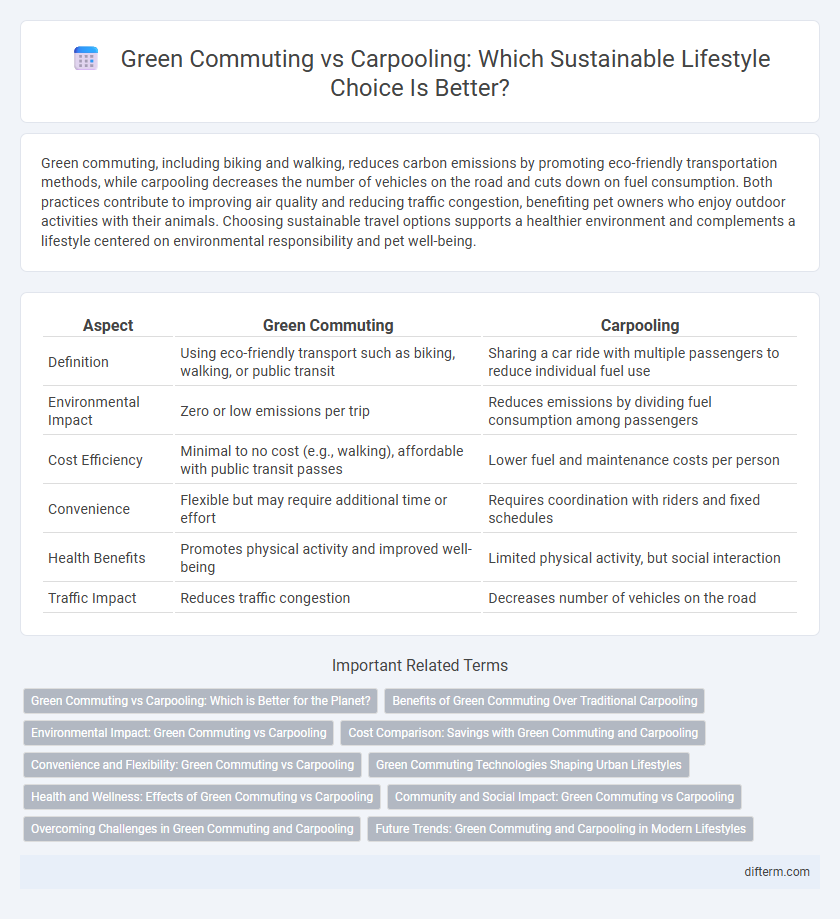Green commuting, including biking and walking, reduces carbon emissions by promoting eco-friendly transportation methods, while carpooling decreases the number of vehicles on the road and cuts down on fuel consumption. Both practices contribute to improving air quality and reducing traffic congestion, benefiting pet owners who enjoy outdoor activities with their animals. Choosing sustainable travel options supports a healthier environment and complements a lifestyle centered on environmental responsibility and pet well-being.
Table of Comparison
| Aspect | Green Commuting | Carpooling |
|---|---|---|
| Definition | Using eco-friendly transport such as biking, walking, or public transit | Sharing a car ride with multiple passengers to reduce individual fuel use |
| Environmental Impact | Zero or low emissions per trip | Reduces emissions by dividing fuel consumption among passengers |
| Cost Efficiency | Minimal to no cost (e.g., walking), affordable with public transit passes | Lower fuel and maintenance costs per person |
| Convenience | Flexible but may require additional time or effort | Requires coordination with riders and fixed schedules |
| Health Benefits | Promotes physical activity and improved well-being | Limited physical activity, but social interaction |
| Traffic Impact | Reduces traffic congestion | Decreases number of vehicles on the road |
Green Commuting vs Carpooling: Which is Better for the Planet?
Green commuting, which includes walking, cycling, and using public transit, significantly lowers carbon emissions compared to carpooling by reducing the total number of vehicles on the road. Carpooling decreases individual car use and emissions per passenger, but it still relies on fossil-fueled vehicles, limiting its environmental benefits. Choosing green commuting modes supports cleaner air, reduces traffic congestion, and promotes sustainable urban living more effectively than carpooling alone.
Benefits of Green Commuting Over Traditional Carpooling
Green commuting, including walking, cycling, and using public transit, reduces carbon emissions more significantly than traditional carpooling, contributing to improved air quality and lower urban congestion. It promotes healthier lifestyles by encouraging physical activity and reducing stress associated with car travel. Green commuting also lowers personal transportation costs by minimizing fuel consumption and vehicle maintenance expenses.
Environmental Impact: Green Commuting vs Carpooling
Green commuting methods, such as biking and walking, significantly reduce carbon emissions by eliminating fuel consumption altogether, whereas carpooling lowers per capita emissions by sharing rides and reducing the number of vehicles on the road. Studies indicate that green commuting can cut individual transportation-related emissions by up to 90%, while carpooling typically achieves a 30-50% reduction depending on passenger count. Both approaches contribute to improved air quality and decreased traffic congestion, supporting sustainable urban mobility goals.
Cost Comparison: Savings with Green Commuting and Carpooling
Green commuting methods such as biking or using public transit significantly reduce transportation costs by eliminating fuel, parking, and maintenance expenses, saving individuals up to $9,000 annually compared to solo driving. Carpooling offers moderate savings by sharing fuel and toll costs among passengers, lowering expenses by approximately 30-50% per participant. Both options contribute to financial savings while promoting sustainable travel habits that reduce overall carbon emissions.
Convenience and Flexibility: Green Commuting vs Carpooling
Green commuting methods such as biking and walking offer unmatched flexibility by allowing individuals to start their journey at any time without dependency on others' schedules. Carpooling, while environmentally beneficial, requires coordination and compromises on departure times and routes, reducing convenience for participants. Choosing green commuting enhances personal autonomy and adaptability in daily travel routines.
Green Commuting Technologies Shaping Urban Lifestyles
Green commuting technologies such as electric scooters, e-bikes, and solar-powered public transit systems are revolutionizing urban lifestyles by reducing carbon footprints and traffic congestion. These innovations promote sustainable mobility options that integrate seamlessly with smart city infrastructures, enhancing air quality and overall public health. Embracing green commuting fosters eco-friendly habits and supports global efforts to combat climate change in metropolitan areas.
Health and Wellness: Effects of Green Commuting vs Carpooling
Green commuting methods such as cycling and walking promote cardiovascular health, reduce stress levels, and improve overall physical fitness by incorporating daily exercise into the routine. Carpooling, while minimizing carbon emissions, offers social interaction benefits and reduces exposure to traffic-related air pollution compared to solo driving. Both approaches contribute positively to mental wellness by lowering commuting stress, but green commuting provides more direct physical health advantages through active movement.
Community and Social Impact: Green Commuting vs Carpooling
Green commuting methods such as cycling, walking, and public transport significantly reduce carbon emissions, fostering a cleaner environment and promoting healthier lifestyles within communities. Carpooling also lowers individual environmental footprints by decreasing the number of vehicles on the road, which reduces traffic congestion and air pollution. Both practices encourage social interaction and strengthen community bonds through shared travel experiences, enhancing collective responsibility toward sustainable living.
Overcoming Challenges in Green Commuting and Carpooling
Overcoming challenges in green commuting and carpooling requires addressing common obstacles such as scheduling conflicts, limited route flexibility, and lack of infrastructure. Implementing mobile apps for real-time coordination, expanding dedicated bike lanes, and providing incentives for shared rides can significantly improve participation rates. Community engagement and supportive policies help create a seamless, eco-friendly transportation network that reduces carbon emissions and traffic congestion.
Future Trends: Green Commuting and Carpooling in Modern Lifestyles
Green commuting and carpooling are rapidly evolving as essential components of sustainable urban mobility, driven by increasing environmental awareness and advancements in transportation technology. Innovations such as electric vehicles, ride-sharing apps, and smart traffic management systems are enhancing the efficiency and appeal of sharing rides, reducing carbon footprints and traffic congestion. Future trends indicate a growing integration of green commuting options within smart city infrastructures, promoting cleaner air quality and healthier lifestyles.
Green commuting vs Carpooling Infographic

 difterm.com
difterm.com